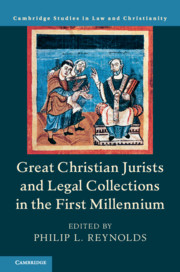Book contents
- Great Christian Jurists and Legal Collections in the First Millennium
- Law and Christianity
- Great Christian Jurists and Legal Collections in the First Millennium
- Copyright page
- Contents
- Contributors
- Preface and Acknowledgments
- Abbreviations
- Part I
- Part II
- 10 Lactantius
- 11 Ambrosiaster
- 12 Augustine of Hippo
- 13 Leo the Great
- 14 Gelasius I
- 15 Dionysius Exiguus
- 16 Benedict’s Rule
- 17 Gregory the Great
- 18 Isidore of Seville
- 19 Pseudo-Isidorus Mercator
- 20 Jonas of Orléans
- 21 Hincmar of Reims
- 22 Regino of Prüm
- 23 Burchard of Worms
- 24 New Horizons in Church Law
- Index
- References
14 - Gelasius I
from Part II
Published online by Cambridge University Press: 21 June 2019
- Great Christian Jurists and Legal Collections in the First Millennium
- Law and Christianity
- Great Christian Jurists and Legal Collections in the First Millennium
- Copyright page
- Contents
- Contributors
- Preface and Acknowledgments
- Abbreviations
- Part I
- Part II
- 10 Lactantius
- 11 Ambrosiaster
- 12 Augustine of Hippo
- 13 Leo the Great
- 14 Gelasius I
- 15 Dionysius Exiguus
- 16 Benedict’s Rule
- 17 Gregory the Great
- 18 Isidore of Seville
- 19 Pseudo-Isidorus Mercator
- 20 Jonas of Orléans
- 21 Hincmar of Reims
- 22 Regino of Prüm
- 23 Burchard of Worms
- 24 New Horizons in Church Law
- Index
- References
Summary
Gelasius I, bishop of Rome from 492 to 496, stands at the peak of fifth-century bids for Roman primacy against the three largest churches of the Byzantine empire: those of Constantinople, Antioch, and Alexandria. Gelasius’s epistolary decretals reveal the ways in which Christianity shaped law generally, even secular (civil) law, and the ways in which law was constitutive of Christian communities and guided Christian practices. Put simply, the authority of the bishop of Rome was paramount in Gelasius’s view of how society was ordered by God, with the secular rulers and their laws coming a close second, but never before it. This chapter includes a survey of Gelasius’s views on the secular and ecclesiastical realms and on the complex relationship between the two, expressed through his letters and other works, and of their importance for the development of a theology of law. It places his decretals in the context of Roman and Gothic interests in the canons and civil law during the fifth and sixth centuries. It concludes with the reception of Gelasius’s works in the medieval West, especially the lasting influence of his “two powers” theory and its significance for later ages.
Keywords
- Type
- Chapter
- Information
- Publisher: Cambridge University PressPrint publication year: 2019
References
Other Sources for Papal Letters
Further Reading
- 1
- Cited by

